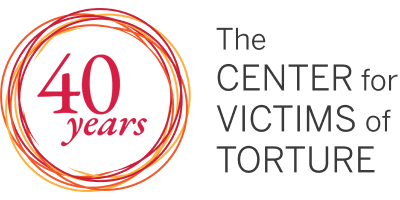Senait* is a young woman who fled to the refugee camp in Ethiopia from her home country of Eritrea. She had been serving in the military and was repeatedly punished for small mistakes. Once she found the safety of a new life in the camp, the weight of all she had survived became very heavy on her, and she found herself having increasing problems with anger and aggressive behavior. She said she felt she could not control it anymore. One day it all became too much, and she was taken to a clinic. While she was there, a CVT clinician visited her and listened to her. She encouraged Senait to come to CVT for care. Over weeks, this clinician did individual counseling with Senait and then supported her as she prepared to join the group counseling sessions. “She treated me like a mother,” Senait said.
Mebratu*, a middle-aged Eritrean man, fled to Ethiopia after being imprisoned in a tiny, underground cell. It was so dark, he could not see his cellmates. They were given so little water, sharing it with the others was a matter of life or death: first for the sustenance and secondly because you might be killed for refusing. He said that once he escaped and had begun his new life in the refugee camp, a CVT counselor noticed him and started saying hello when their paths crossed. Over time, he quietly reached out a hand of kindness to Mebratu and one day said “Why are you alone? Come to CVT.” Mebratu went through the 10-week group counseling cycle and said “Before CVT, I never talked about my experience. I kept it to myself for years; it was hurting me for all those years.”
Outreach by clinical staff in the refugee community is key for bringing torture survivors to CVT Ethiopia for care. There are several tools that CVT uses to reach out within the refugee community to survivors like Senait and Mebratu, including psychoeducation sessions for groups of men, women and children, as well as sensitization sessions, where staff talk to the community about rehabilitative care. In addition, CVT psychosocial counselors who live in the refugee camps, as well as CVT counselors, are connected to social workers and caregivers who let them know when someone needs the kind of care CVT brings.
The effectiveness of these forms of outreach is clear in the numbers of clients who come for care at CVT Ethiopia: in 2016, CVT saw 645 clients in two camps, Adi Harush and Mai Ayni, with an estimated 2,580 family members indirectly benefiting from clients’ improvements.
As these outreach methods have been in continuous use since 2013 when CVT Ethiopia first opened its centers, more and more former clients too have begun their own forms of outreach, helping neighbors get the care they need at CVT. Senait mentioned that now that she has been through the healing process with CVT, she reaches out to others in the camp, urging them to get help. She said “I don’t ignore people who have problems. I want them to get help.”
Counselors administer a holistic assessment with clients at intake, and Esayas Kiflom, program evaluation officer, CVT Ethiopia, analyzes the data about clients as they come to CVT. “Many times,” Esayas noted, “the client will say that a ‘CVT worker told me about CVT.’ Now, more and more we are hearing ‘A former CVT client told me to come.’ Our former clients are in a good position to tell others. If we keep doing what we’re doing, we will have more.”
In addition, CVT’s community education and outreach make progress in correcting the misperception about mental health that can be found in the refugee community: that CVT is a place for people who are “insane.” Yacob Abreha, psychosocial counselor, CVT Ethiopia, participates in a large amount of the community outreach work. He believes in its effectiveness, saying “After we went out and did intensive community sensitization, there has been a change in attitude.” Yacob said that intensive levels of outreach include doing community sessions three days per week, with Tuesdays dedicated to newly-arrived refugees, Wednesdays for specific outreach by zones, and Thursdays dedicated to making door-to-door contacts. Yacob added, “Now people see CVT is for healthy people who have survived traumatic situations.”
Osman*, another former client at CVT Ethiopia, found that his problems and stress were so severe after arriving in the Ethiopian refugee camp that he needed to be treated by a psychiatrist in a clinic. There, he spoke to a former CVT client, who told him “It’s good at CVT.” Hearing from another refugee made all the difference, and Osman came for care. He spoke about the need to overcome the stigma associated with mental health care, saying “Many people believe CVT is for the mentally ill. But it’s not. It’s like college; you get shaped at CVT.”
Osman added, “CVT helps us changing from non-life to life.”
Read Senait’s story here.
*Name and some details have been changed for safety and to protect confidentiality.
CVT’s work with Eritrean refugees in Ethiopia is funded by a grant from the U.S. State Department’s Bureau of Population, Refugees, and Migration.
